
Chapter 3 - Scales, Keys, and Modes
Chromatic, Major, and Minor Scales
Scales - An ordered collection of pitches in whole- and half-step patterns.
The word comes from Latin “scalae” meaning stairs.
The Chromatic Scale
Chromatic scale - Symmetrical scale with all pitches spaced a half step apart.
Sharps are used for the ascending scale.
Enharmonic equivalent flats are used for the descending scale.
The Major Scale Pattern
Major scale - Created using a pattern for whole and half steps. It’s asymmetrical.
Church mode - A scale containing five whole steps and two half steps. There are seven of them.
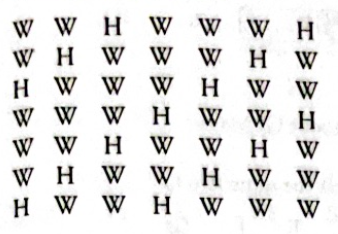
Ionian mode - First rotation, it is a major scale pattern.
Aeolian mode - Sixth rotation, it’s a minor scale pattern.
Key - A specific series of pitches based on a pattern of whole and half steps that define a tonality.
Key of G - The series of notes using the major scale pattern centered around, or starting with G.
Tonality - The principle of organizing a composition around that keynote or tonic.
Mode - An issue of scale type.
There are 15 major scales, 3 of these are enharmonic:
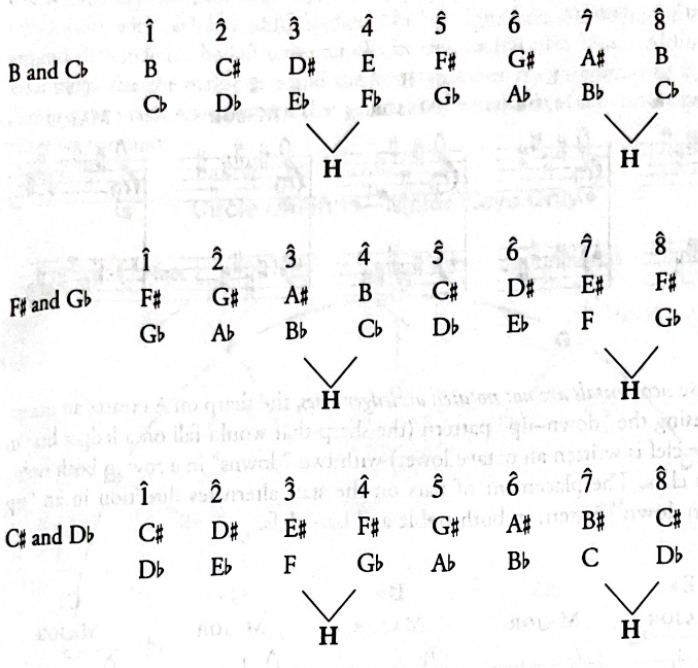
Key signature - A form of shorthand that dispenses with the writing of accidentals (sharps and flats) for the notes affected by the pattern.
Placement of Key Signatures on the Grand Staff
The key signature is always written on the staff between the clef and the meter signature. The placement of sharps alternates in a down-up pattern.

The placement of flats on the staff alternates direction in an up-down pattern in both treble and bass clefs.

Identifying the Key from the Key Signature
For sharps - The last sharp in the key signature is scale degree 7, so the name of the key is up one-half step.
For flats - The last flat in the key signature is scale degree 4, so the name of the key is the next to the last flat in the key signature.
The Circle of Fifths
The circle of fifths - Demonstrates the relationship of the tonal centers to each other.
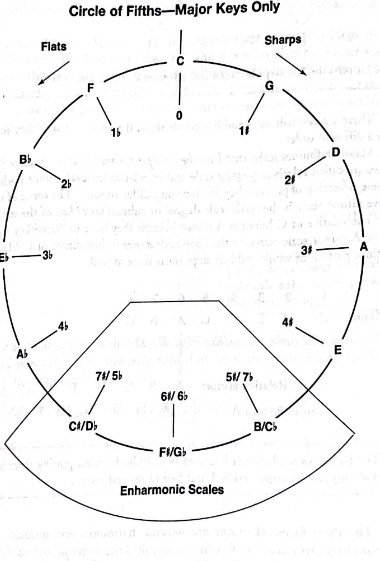
The Minor Scale Pattern
Natural minor scale - The sixth scale in the rotation of church modes.
There are three forms of the minor scale and they all come from the natural minor scale which is:

Relative - Major and minor scales that have the same pitches and key signature.
Three forms of minor - Natural, harmonic, and melodic.
Minor pentachord - Same first five notes that the three forms of minor start with.
Parallel - Major and minor keys with different key signature but same tonic.
Natural form of minor - No alterations to the key signature.
Harmonic form of minor - The 7th scale degree is raised both ascending and descending.
Melodic form of minor - The 6th and 7th scale degrees are raised.

Circle of Fifths
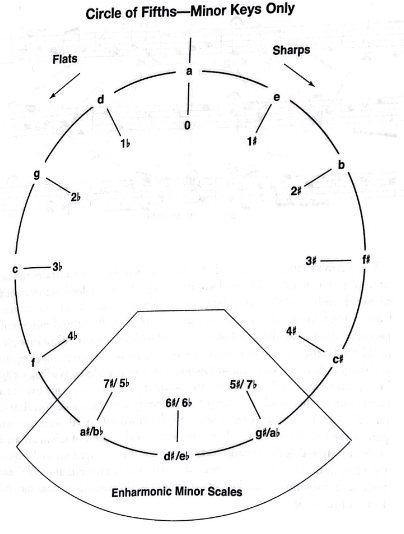
Scalar variance - The use of natural, harmonic, and melodic minor within one composition.
Artificial scales - When forms of the minor vary from the key signature and require the use of additional accidentals to create the scale.
Full Circle of Fifths
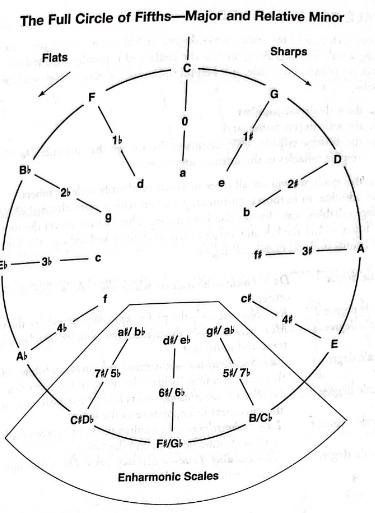
Scale Degree Names
Scale degree - Each step of the scale.
Tonic - The beginning pitch of the scale.
Scale degree 1 - The tone on which the scale is built, the tonal center.
Do = Tonic
Scale degree 2 - Above the tonic.
Re = Supertonic
Scale degree 3 - Halfway between the tonic and dominant.
Mi = Mediant
Scale degree 4 - A fifth below the tonic
Fa = Subdominant
Scale degree 5 - Perfect fifth above the tonic
So (Sol) = Dominant
Scale degree 6 - In between the subdominant and the tonic
La = Submediant
Scale degree 7 - Half step below Do.
Ti = Leading tone
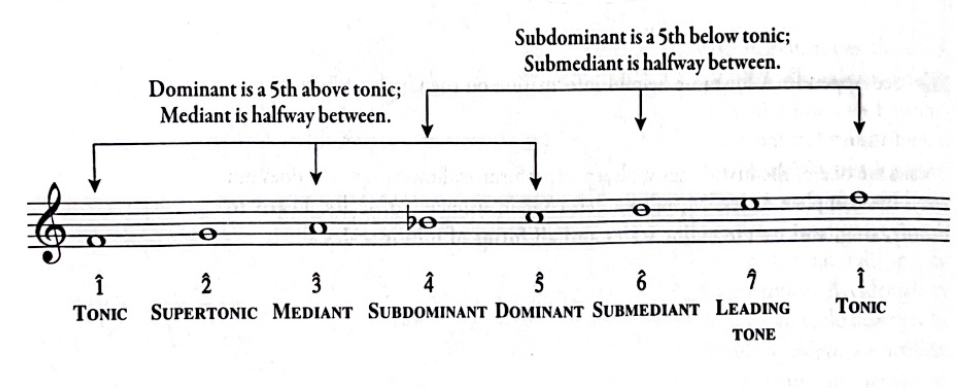
Major Scale

Minor Scales
Natural minor scale
The 7th scale degree is a whole step below tonic, meaning it’s subtonic.

Harmonic minor scale
The 7th scale degree is raised and a leading tone, it is one-half step below the tonic.

Melodic minor scale
The 7th scale degree is leading and the 6th scale is the raised submediant.

Active tones - Scale degrees 4, 6, and 7.
Within the major scale, the 4th and 7th scale degrees are the most active tones and have half-steps relationships to the most stable tones which are the 3rd and the tonic. Scale degrees 1 and 3 are resolution tones are the notes to which the active tones move.
The 6th scale degree resolves down to the 5th.

Whole-Tone and Pentatonic Scales
Whole-Tone Scale
Heptatonic scales - There are seven tones in the scale. Major and minor scales are heptatonic.
Hexatonic scale - There are six tones in this scale. The whole-tone scale is hexatonic.
Whole-tone scale - Each pitch is a whole step apart.
Pentatonic Scale
Pentatonic scale - Has five tones. It contains no half steps or active tones.
Major pentatonic - To build it, in the Circle of Fifths, start from C up to 5 consecutive pitches.
Relative minor pentatonic - It uses the same pitch as the C pentatonic but it starts on A.
Church Modes
Ionian mode - Same pattern as the major scale
Aeolian mode - Same pattern as the natural minor scale

Phrygian, Aeolian, and Dorian are minor modes.
Dorian is similar to Aeolian with a raised 6th scale degree.
Phrygian is similar to Aeolian with a lowered 2nd scale degree.
Dorian adds one sharp and Phrygian adds one flat.
Lydian, Mixolydian, and Ionian are major modes.
Lydian is similar to Ionian with a raised 4th scale degree.
Mixolydian is similar to Ionian with a lowered 7th scale degree.
Lydian adds one sharp and Mixolydian adds one flat.
Locrian is used less. It has a diminished tonic triad, so it’s not a major or minor.
Chapter 3 - Scales, Keys, and Modes
Chromatic, Major, and Minor Scales
Scales - An ordered collection of pitches in whole- and half-step patterns.
The word comes from Latin “scalae” meaning stairs.
The Chromatic Scale
Chromatic scale - Symmetrical scale with all pitches spaced a half step apart.
Sharps are used for the ascending scale.
Enharmonic equivalent flats are used for the descending scale.
The Major Scale Pattern
Major scale - Created using a pattern for whole and half steps. It’s asymmetrical.
Church mode - A scale containing five whole steps and two half steps. There are seven of them.

Ionian mode - First rotation, it is a major scale pattern.
Aeolian mode - Sixth rotation, it’s a minor scale pattern.
Key - A specific series of pitches based on a pattern of whole and half steps that define a tonality.
Key of G - The series of notes using the major scale pattern centered around, or starting with G.
Tonality - The principle of organizing a composition around that keynote or tonic.
Mode - An issue of scale type.
There are 15 major scales, 3 of these are enharmonic:

Key signature - A form of shorthand that dispenses with the writing of accidentals (sharps and flats) for the notes affected by the pattern.
Placement of Key Signatures on the Grand Staff
The key signature is always written on the staff between the clef and the meter signature. The placement of sharps alternates in a down-up pattern.

The placement of flats on the staff alternates direction in an up-down pattern in both treble and bass clefs.

Identifying the Key from the Key Signature
For sharps - The last sharp in the key signature is scale degree 7, so the name of the key is up one-half step.
For flats - The last flat in the key signature is scale degree 4, so the name of the key is the next to the last flat in the key signature.
The Circle of Fifths
The circle of fifths - Demonstrates the relationship of the tonal centers to each other.

The Minor Scale Pattern
Natural minor scale - The sixth scale in the rotation of church modes.
There are three forms of the minor scale and they all come from the natural minor scale which is:

Relative - Major and minor scales that have the same pitches and key signature.
Three forms of minor - Natural, harmonic, and melodic.
Minor pentachord - Same first five notes that the three forms of minor start with.
Parallel - Major and minor keys with different key signature but same tonic.
Natural form of minor - No alterations to the key signature.
Harmonic form of minor - The 7th scale degree is raised both ascending and descending.
Melodic form of minor - The 6th and 7th scale degrees are raised.

Circle of Fifths

Scalar variance - The use of natural, harmonic, and melodic minor within one composition.
Artificial scales - When forms of the minor vary from the key signature and require the use of additional accidentals to create the scale.
Full Circle of Fifths

Scale Degree Names
Scale degree - Each step of the scale.
Tonic - The beginning pitch of the scale.
Scale degree 1 - The tone on which the scale is built, the tonal center.
Do = Tonic
Scale degree 2 - Above the tonic.
Re = Supertonic
Scale degree 3 - Halfway between the tonic and dominant.
Mi = Mediant
Scale degree 4 - A fifth below the tonic
Fa = Subdominant
Scale degree 5 - Perfect fifth above the tonic
So (Sol) = Dominant
Scale degree 6 - In between the subdominant and the tonic
La = Submediant
Scale degree 7 - Half step below Do.
Ti = Leading tone

Major Scale

Minor Scales
Natural minor scale
The 7th scale degree is a whole step below tonic, meaning it’s subtonic.

Harmonic minor scale
The 7th scale degree is raised and a leading tone, it is one-half step below the tonic.

Melodic minor scale
The 7th scale degree is leading and the 6th scale is the raised submediant.

Active tones - Scale degrees 4, 6, and 7.
Within the major scale, the 4th and 7th scale degrees are the most active tones and have half-steps relationships to the most stable tones which are the 3rd and the tonic. Scale degrees 1 and 3 are resolution tones are the notes to which the active tones move.
The 6th scale degree resolves down to the 5th.

Whole-Tone and Pentatonic Scales
Whole-Tone Scale
Heptatonic scales - There are seven tones in the scale. Major and minor scales are heptatonic.
Hexatonic scale - There are six tones in this scale. The whole-tone scale is hexatonic.
Whole-tone scale - Each pitch is a whole step apart.
Pentatonic Scale
Pentatonic scale - Has five tones. It contains no half steps or active tones.
Major pentatonic - To build it, in the Circle of Fifths, start from C up to 5 consecutive pitches.
Relative minor pentatonic - It uses the same pitch as the C pentatonic but it starts on A.
Church Modes
Ionian mode - Same pattern as the major scale
Aeolian mode - Same pattern as the natural minor scale

Phrygian, Aeolian, and Dorian are minor modes.
Dorian is similar to Aeolian with a raised 6th scale degree.
Phrygian is similar to Aeolian with a lowered 2nd scale degree.
Dorian adds one sharp and Phrygian adds one flat.
Lydian, Mixolydian, and Ionian are major modes.
Lydian is similar to Ionian with a raised 4th scale degree.
Mixolydian is similar to Ionian with a lowered 7th scale degree.
Lydian adds one sharp and Mixolydian adds one flat.
Locrian is used less. It has a diminished tonic triad, so it’s not a major or minor.
 Knowt
Knowt
